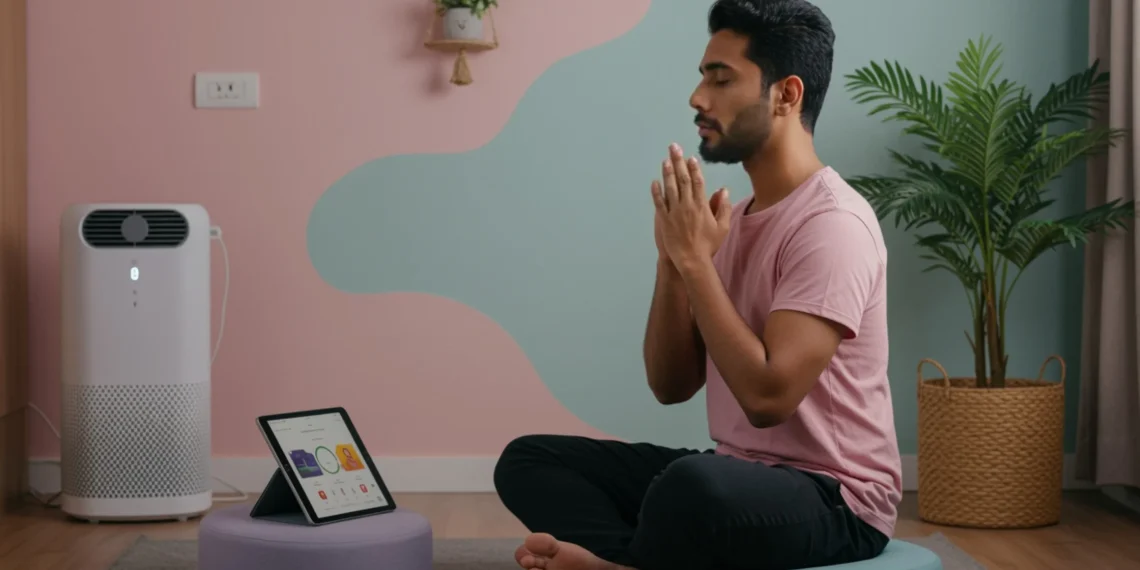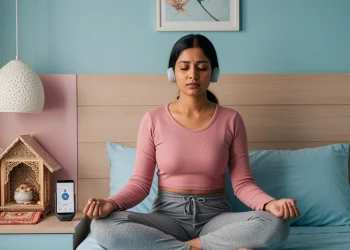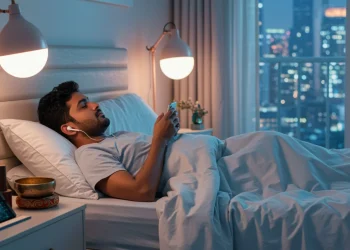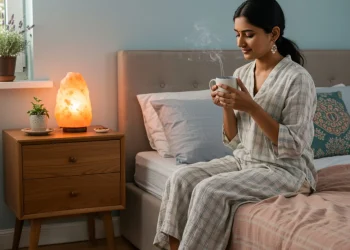Discover how ancient breathing exercises for sleep can transform your nights and unlock deeper, more restorative rest through time-tested pranayama techniques.
The Science Behind Breathing and Sleep Quality: Where Ancient Wisdom Meets Modern Research
The connection between our breath and sleep quality runs far deeper than most people realize. Every night, as you prepare for rest, your breathing patterns hold the key to either peaceful slumber or restless tossing and turning. Modern sleep science has finally caught up with what ancient yogic traditions have known for thousands of years: controlled breathing is one of the most powerful tools for inducing natural sleep.
Your autonomic nervous system, which controls involuntary functions like heartbeat and breathing, operates through two primary branches. The sympathetic nervous system keeps you alert and ready for action, while the parasympathetic nervous system promotes rest, repair, and restoration. When you practice specific breathing exercises for sleep, you’re essentially sending a direct signal to your parasympathetic nervous system to take charge, creating the ideal physiological conditions for deep rest.
Research published in the Journal of Clinical Medicine shows that controlled breathing techniques can reduce cortisol levels by up to 23% within just 10 minutes of practice. Cortisol, often called the stress hormone, is one of the primary culprits behind sleep difficulties. When cortisol levels remain elevated in the evening, your body struggles to produce adequate melatonin, the hormone responsible for regulating your sleep-wake cycle. This creates a cascade effect where poor sleep leads to higher stress, which further disrupts sleep quality.
The physiological magic happens when you consciously slow down your breathing rate from the typical 12-20 breaths per minute to 4-6 breaths per minute. This dramatic reduction activates the vagus nerve, the longest cranial nerve that runs from your brain stem to your abdomen. When stimulated through slow, deep breathing, the vagus nerve triggers the release of GABA (gamma-aminobutyric acid), a neurotransmitter that naturally calms brain activity and promotes relaxation.
Pranayama for sleep takes this scientific understanding and enhances it through centuries-refined techniques that address not just the physical act of breathing, but the mental and energetic aspects of rest preparation. Unlike simple deep breathing, pranayama involves specific ratios, retention patterns, and mental focuses that create profound shifts in consciousness, making the transition from wakefulness to sleep both smoother and more complete.
Studies conducted at Harvard Medical School have documented measurable changes in brain wave patterns during pranayama practice. EEG readings show a significant increase in alpha waves (associated with relaxation) and theta waves (linked to the drowsy state that precedes sleep). Participants who practiced pranayama techniques for just four weeks showed a 42% improvement in sleep onset time and a 65% increase in deep sleep duration compared to control groups.
The temperature regulation aspect of breathing also plays a crucial role in sleep preparation. Certain pranayama techniques naturally cool the body, mimicking the natural temperature drop that signals to your brain that it’s time to sleep. When you practice cooling breath techniques like Sheetali or Sheetkari pranayama, you’re working with your body’s circadian rhythms rather than against them.
Perhaps most importantly, pranayama addresses the modern epidemic of “racing mind” syndrome that keeps millions awake each night. When you focus intently on breath patterns, counts, and retention, you’re giving your mind a single-pointed focus that naturally quiets the mental chatter. This meditative aspect of breathing exercises creates what sleep researchers call “cognitive de-arousal,” the mental shift necessary for peaceful sleep.
Traditional Pranayama Techniques for Evening: Ancient Practices for Modern Sleep Challenges
The evening hours have always held special significance in yogic tradition, representing the transition from active engagement with the world to inner reflection and rest. Traditional pranayama techniques for this sacred time are specifically designed to honor this natural rhythm while preparing both body and mind for restorative sleep. These practices, refined over millennia, offer a gentle yet powerful alternative to modern sleep aids.
Nadi Shodhana (Alternate Nostril Breathing) stands as perhaps the most balancing of all evening pranayama practices. This technique works by harmonizing the left and right hemispheres of the brain, creating a state of mental equilibrium that’s essential for quality sleep. The practice involves using your thumb to close the right nostril while inhaling through the left, then switching to close the left nostril while exhaling through the right. This pattern continues, creating a rhythmic flow that naturally calms the nervous system.
Scientific studies have shown that Nadi Shodhana can reduce anxiety levels by up to 34% and significantly improve heart rate variability, a key indicator of stress resilience. When practiced consistently in the evening, this technique helps reset your nervous system from the day’s accumulated stress, creating the optimal internal environment for sleep. The beauty of Nadi Shodhana lies in its ability to balance opposing energies within the body, neither over-stimulating nor under-energizing, but finding that perfect middle ground conducive to rest.
Ujjayi Pranayama, often called “ocean breath” for its gentle whooshing sound, serves as another cornerstone of evening practice. Unlike the vigorous Ujjayi used during active yoga practice, evening Ujjayi is performed at a much slower pace with longer, deeper breaths. The technique involves breathing through the nose while gently constricting the throat muscles, creating a soft, ocean-like sound that becomes a natural focal point for meditation.
The hypnotic quality of Ujjayi breath naturally induces a trance-like state that bridges the gap between conscious awareness and sleep. Many practitioners find that the rhythmic sound becomes a form of internal white noise, drowning out external distractions and mental chatter. The extended exhalation phase of Ujjayi particularly activates the parasympathetic nervous system, signaling to your body that it’s safe to rest and repair.
Brahmari Pranayama (Humming Bee Breath) represents one of the most immediately effective techniques for evening relaxation. This practice involves creating a humming sound during exhalation, similar to the gentle buzz of a bee. The vibration created by humming stimulates the vagus nerve while also creating internal sound waves that calm the mind. Research has shown that the frequency of humming can increase nitric oxide production by up to 15 times normal levels, improving circulation and promoting relaxation.
The traditional approach to Brahmari involves placing the thumbs in the ears and the remaining fingers over closed eyes, creating complete sensory withdrawal. This technique, known as Shanmukhi Mudra, enhances the inward-turning quality essential for sleep preparation. The combination of humming, darkness, and silence creates a cocoon-like environment that naturally induces drowsiness.
Chandra Bhedana (Left Nostril Breathing) specifically targets the cooling, calming energy channels associated with lunar energy in yogic philosophy. By breathing exclusively through the left nostril, you activate the parasympathetic nervous system while simultaneously cooling the body temperature. This technique is particularly beneficial during warmer months or for individuals who tend to run hot at night.
The practice involves using the right thumb to close the right nostril while breathing slowly and deeply through the left nostril only. Traditional texts recommend practicing Chandra Bhedana for 5-10 minutes before bed, allowing the cooling energy to permeate throughout the system. Modern sleep research confirms that a slight drop in core body temperature is one of the strongest signals for sleep onset, making this ancient technique remarkably aligned with contemporary understanding.
4-7-8 Breathing with Indian Modifications: Bridging Eastern Wisdom and Western Innovation
The 4-7-8 breathing technique, popularized by Dr. Andrew Weil, represents a fascinating fusion of ancient pranayama principles with modern sleep medicine. However, the traditional Indian approach to breath retention and counting offers several modifications that can enhance the effectiveness of this powerful technique while honoring its yogic roots. These modifications take into account the subtle energy work and philosophical foundations that make pranayama a holistic practice rather than merely a breathing exercise.
The basic 4-7-8 pattern involves inhaling for 4 counts, holding the breath for 7 counts, and exhaling for 8 counts. While this ratio creates the desired physiological response, traditional Indian modifications suggest beginning with gentler ratios and gradually building capacity. The classical approach recommends starting with a 4-4-6 pattern, allowing the nervous system to adapt slowly rather than creating strain that could actually increase anxiety rather than reduce it.
In traditional pranayama, the concept of “Kumbhaka” or breath retention is considered an advanced practice that requires proper preparation. Indian masters emphasize that forced retention can create tension rather than relaxation, particularly for beginners. The modified approach suggests focusing primarily on extending the exhalation phase initially, using ratios like 4-2-8 or even 4-0-8, where the retention is minimal or eliminated entirely until comfort is established.
The integration of mantras with the 4-7-8 technique adds a profound dimension often missing from Western adaptations. During the inhalation phase, practitioners might silently repeat “So” (Sanskrit for “I am”), during retention “Hum” (representing universal consciousness), and during exhalation “Sa” (meaning peace). This mental repetition serves multiple purposes: it provides a focus point to prevent mind wandering, imbues the practice with spiritual significance, and creates a rhythm that naturally guides the breath timing.
Another significant Indian modification involves the concept of “Bhava” or attitude during practice. Rather than approaching 4-7-8 breathing as a mechanical technique to induce sleep, the traditional approach encourages cultivating a sense of surrendering the day’s experiences with each exhalation. This emotional release component often proves more effective than the breathing pattern alone, as it addresses the mental holding patterns that frequently prevent sleep.
The use of mudras (hand positions) with modified 4-7-8 breathing enhances the practice’s effectiveness through energy redirection. The Gyan Mudra (thumb and index finger touching) is particularly recommended during evening practice, as it’s believed to calm the nervous system and promote wisdom. Some practitioners place one hand on the heart and one on the belly, creating a connection between breath awareness and emotional centering.
Traditional Indian timing for 4-7-8 practice differs from the common Western recommendation of four cycles. Classical texts suggest practicing for a duration measured in minutes rather than repetitions, typically 5-10 minutes of continuous practice. This allows for a deeper state of relaxation to develop gradually rather than creating anticipation around completing a specific number of cycles.
Temperature awareness represents another crucial Indian modification. Traditional practice emphasizes breathing through the nose while being mindful of the breath’s temperature. The inhalation should feel cool and refreshing, while the exhalation should feel warm and releasing. This temperature sensitivity helps practitioners develop a more refined awareness of their breathing patterns and enhances the overall calming effect.
The classical approach also incorporates seasonal modifications to the 4-7-8 pattern. During warmer months, the retention phase might be shortened, and emphasis placed on cooling the breath through slight tongue positioning. In cooler seasons, the retention might be extended slightly, and warming techniques incorporated. This seasonal awareness reflects the Indian understanding that optimal breathing practices should harmonize with natural cycles.
Bhramari and Other Calming Techniques: The Sound and Silence of Sleep Preparation
Among the vast repository of pranayama techniques, Bhramari Pranayama stands out as uniquely suited for evening practice and sleep preparation. The technique’s name derives from the Sanskrit word for “bee,” reflecting the gentle humming sound created during exhalation. This practice represents one of the most immediately effective methods for transitioning from daytime alertness to evening calm, offering both physiological benefits and deep psychological relaxation.
The full Bhramari practice incorporates Shanmukhi Mudra, where the practitioner uses their fingers to gently seal the sensory openings of the face. The thumbs close the ears, the index fingers rest lightly on closed eyelids, the middle fingers on the sides of the nose, and the ring and little fingers on the upper and lower lips respectively. This complete sensory withdrawal, known as Pratyahara in yogic philosophy, creates an internal environment perfect for deep relaxation and sleep preparation.
Research conducted at AIIMS (All India Institute of Medical Sciences) found that regular Bhramari practice increases the production of nitric oxide by 400%, significantly more than other breathing techniques. Nitric oxide plays a crucial role in regulating blood pressure, improving circulation, and promoting cellular relaxation. The humming vibration also stimulates the vagus nerve more effectively than silent breathing techniques, creating a cascade of calming neurotransmitter release.
The sound component of Bhramari serves multiple functions beyond its physiological effects. The self-generated humming creates a form of sound therapy that masks external distractions while providing the mind with a single focal point. Many practitioners report that the humming naturally evolves into a meditative state where the sound seems to arise effortlessly, creating a bridge between conscious practice and unconscious sleep.
Bhramari variations for different constitutions and needs make this technique accessible to virtually everyone. For individuals with sinus congestion, the humming can be done with the mouth slightly open, allowing for easier breathing while maintaining the vibrational benefits. Those sensitive to pressure on the eyes can practice with hands in prayer position while still creating the humming sound. Pregnant women can practice Bhramari without the Shanmukhi Mudra, focusing purely on the gentle humming during exhalation.
Anulom Vilom (Systematic Alternate Nostril Breathing) complements Bhramari perfectly as part of an evening sequence. Unlike Nadi Shodhana, which balances the nervous system, Anulom Vilom specifically prepares the respiratory system for the slower, deeper breathing patterns of sleep. The technique involves controlled, systematic breathing through alternate nostrils with specific attention to equalizing the breath flow on both sides.
The evening version of Anulom Vilom emphasizes longer exhalations and gentle, natural retention rather than forced holding. This variation helps clear any nasal congestion that might interfere with sleep breathing while also calming the mind through focused attention. The systematic nature of the practice creates a rhythmic meditation that naturally leads toward drowsiness.
Sheetali and Sheetkari Pranayama offer cooling techniques particularly valuable during warmer weather or for individuals who experience night sweats. Sheetali involves inhaling through a curled tongue, while Sheetkari uses a slightly opened mouth with the tongue against the teeth. Both techniques cool the incoming air and activate the parasympathetic nervous system through temperature regulation.
These cooling pranayamas work by triggering the body’s natural sleep preparation process, which includes a slight drop in core temperature. The cooling effect extends beyond mere temperature regulation to include calming the “internal heat” associated with stress, anxiety, and overstimulation. Many practitioners find these techniques particularly effective when combined with visualization of cool, peaceful environments.
Surya Bhedana (Right Nostril Breathing) might seem counterintuitive for evening practice, as it’s traditionally associated with heating and energizing. However, when practiced gently for just 2-3 minutes at the beginning of an evening routine, it can help complete the day’s activities mentally and emotionally. This brief practice helps “close” the active day cycle before transitioning to cooling, calming techniques.
The integration of these various techniques creates a comprehensive approach to evening pranayama that addresses different aspects of sleep preparation. Rather than relying on a single technique, the traditional approach involves creating a sequence that moves from gentle completion (Surya Bhedana) through balancing (Anulom Vilom) to deep relaxation (Bhramari) and cooling (Sheetali/Sheetkari as needed).
Creating a Breathing Routine: Your Personal Path to Restful Nights
Establishing a consistent breathing routine for sleep requires more than simply learning techniques; it involves creating a sustainable practice that honors your lifestyle, constitution, and specific sleep challenges. The most effective evening pranayama routine becomes a bridge between your day’s activities and night’s rest, serving as both a practical tool and a ritual that signals to your body and mind that it’s time to transition into sleep mode.
The foundation of any effective breathing routine begins with timing and environment. Traditional Ayurvedic wisdom suggests beginning your evening pranayama practice during the “Vata time” of day, approximately 1.5-2 hours before your intended sleep time. This timing allows the calming effects of the practice to deepen gradually while avoiding the common mistake of practicing so close to bedtime that you fall asleep during the exercises themselves.
Creating your practice space involves more than physical considerations; it’s about establishing energetic boundaries between your active day and restful night. Choose a consistent location that you can dedicate to this transition time, even if it’s simply a corner of your bedroom with a comfortable cushion. The key lies in consistency rather than perfection – your nervous system will begin to recognize this space as a cue for relaxation.
A comprehensive 15-20 minute evening routine might follow this progression: Begin with 2-3 minutes of Surya Bhedana to complete and release the day’s energy, followed by 5-7 minutes of Nadi Shodhana to balance and center the nervous system. Transition into 5-8 minutes of Bhramari with Shanmukhi Mudra for deep internal quieting, and conclude with 2-3 minutes of 4-7-8 breathing or Chandra Bhedana for final preparation for sleep.
This sequence honors the natural progression from completion through balancing to deep relaxation and finally to sleep preparation. However, the beauty of pranayama lies in its adaptability to individual needs and circumstances. Some evenings you might need more balancing if the day was particularly stressful, while other times you might benefit from extended cooling techniques if you’re feeling overheated or agitated.
For beginners, starting with a simplified 5-10 minute routine prevents overwhelm while establishing the habit. Begin with just 3-5 minutes of Nadi Shodhana followed by 3-5 minutes of gentle Bhramari. As comfort and familiarity develop, gradually add other techniques and extend the duration. The key principle in traditional pranayama is “slow and steady progress” rather than forcing advanced practices prematurely.
Tracking your routine’s effectiveness helps refine your practice over time. Keep a simple sleep journal noting which techniques you practiced, for how long, and the quality of your subsequent sleep. Notice patterns – perhaps Bhramari works particularly well after stressful days, or cooling techniques are more effective during certain seasons. This awareness allows you to customize your routine based on your body’s responses rather than following a rigid formula.
Environmental factors significantly impact the effectiveness of your breathing routine. The ideal practice environment is slightly cool, well-ventilated, and free from electronic devices. Consider incorporating subtle aromatherapy with lavender or sandalwood, which research shows can enhance the relaxation response when combined with breathing practices. Dim lighting or candlelight can help signal the transition from day to night consciousness.
Seasonal adjustments to your routine reflect the traditional understanding that optimal practices harmonize with natural cycles. During summer months, emphasize cooling techniques like Sheetali and longer exhalation phases. Winter practices might include more warming approaches and slightly extended retention periods. Spring calls for more balancing techniques, while autumn benefits from grounding, stabilizing practices.
The integration of intention-setting into your routine adds a psychological dimension that enhances the physical benefits. Before beginning your practice, take a moment to consciously release the day’s concerns and set an intention for peaceful rest. This mental component helps prevent the common experience of lying in bed replaying the day’s events or worrying about tomorrow’s responsibilities.
Troubleshooting common routine challenges ensures long-term success. If you find yourself falling asleep during practice, shorten the duration or practice slightly earlier. If the techniques feel too stimulating, focus on the exhalation phase and reduce any retention components. For those who travel frequently, identify 2-3 core techniques that can be practiced anywhere, maintaining consistency even when your environment changes.
Safety Considerations and Contraindications: Practicing Wisdom with Awareness
While pranayama offers profound benefits for sleep and overall well-being, like any powerful practice, it requires intelligent application and awareness of potential contraindications. The ancient texts emphasize that pranayama should enhance life force rather than create strain or imbalance, making proper understanding of safety considerations essential for effective and sustainable practice.
Breath retention practices require particular caution, especially for individuals with cardiovascular conditions, high blood pressure, or respiratory disorders. Any technique involving holding the breath should be approached gradually and never forced. If you experience dizziness, rapid heartbeat, or any discomfort during retention, immediately return to normal breathing and consider eliminating retention phases from your practice until you can consult with a qualified instructor.
Traditional guidelines suggest that pregnant women should avoid all breath retention practices after the first trimester and focus exclusively on gentle, natural breathing patterns. Techniques like gentle Ujjayi, modified Bhramari (without Shanmukhi Mudra), and simple alternate nostril breathing without retention can provide benefits without creating any risk to mother or child. Always consult with both your healthcare provider and a knowledgeable pranayama instructor before practicing during pregnancy.
Individuals with anxiety disorders or panic attack history should approach pranayama with extra sensitivity, as intense focus on breathing can occasionally trigger anxiety in susceptible individuals. Begin with the gentlest techniques, particularly those emphasizing extended exhalation rather than breath retention. If you notice increased anxiety during or after practice, focus on natural, uncontrolled breathing for several days before attempting any structured techniques again.
The concept of “appropriate effort” in pranayama cannot be overstated. Unlike physical exercise where “no pain, no gain” might apply, pranayama should always feel comfortable and sustainable. Any technique that creates strain, force, or struggle defeats its purpose and may actually increase stress rather than reduce it. The breath should flow naturally within the chosen pattern, never feeling forced or constrained.
Timing considerations extend beyond just when to practice to include awareness of your body’s natural rhythms and current state. Avoid pranayama practice when you’re extremely hungry, immediately after eating, during acute illness, or when experiencing strong emotional disturbance. The nervous system needs stability to benefit from breathing practices, and attempting pranayama during unstable states can sometimes amplify rather than calm disturbance.
Certain medical conditions require modified approaches or complete avoidance of specific techniques. Individuals with heart conditions should avoid any rapid breathing techniques and focus on gentle, slow practices. Those with lung conditions like asthma should practice only under qualified guidance and may need to avoid techniques that involve extended exhalation. People with epilepsy should be particularly cautious with any technique involving rapid breathing or extended retention.
The interaction between medications and pranayama deserves careful consideration. Blood pressure medications, anti-anxiety medications, and sleep aids can all be affected by regular pranayama practice as the techniques naturally influence these same systems. While this interaction is generally positive, it’s essential to work with your healthcare provider to monitor any changes and potentially adjust medications as your natural relaxation response improves.
Mental health considerations include understanding that pranayama can sometimes surface suppressed emotions or memories. This is generally considered a positive aspect of practice, but it can be surprising or overwhelming for some practitioners. If you experience unusual emotional responses during or after practice, consider working with a qualified teacher who understands both the therapeutic and potentially challenging aspects of breathwork.
Children’s pranayama practice requires age-appropriate modifications. Generally, children under 8 should only practice playful breathing games rather than formal pranayama. Adolescents can learn basic techniques but should avoid retention practices until physical and emotional maturity. The emphasis for younger practitioners should always be on fun, gentle breathing awareness rather than structured techniques.
Environmental safety includes ensuring proper ventilation during practice and avoiding pranayama in polluted environments. The deep breathing inherent in these practices means you’re taking in larger volumes of air, making air quality particularly important. Practice in well-ventilated indoor spaces or clean outdoor environments when possible.
Signs that indicate you should stop or modify your practice include persistent dizziness, headaches, unusual fatigue, increased anxiety, sleep disturbances (ironically), or any feeling that the practice is becoming a source of stress rather than relief. Remember that the goal of evening pranayama is to enhance your natural ability to rest peacefully, and any practice that interferes with this goal needs adjustment.
The traditional approach emphasizes learning from qualified teachers whenever possible, particularly when progressing to more advanced techniques. While basic practices can be learned safely from written instructions, having an experienced guide helps prevent the development of poor habits and provides personalized modifications based on your unique constitution and needs.
Perhaps most importantly, maintain a spirit of patient experimentation rather than forcing results. The benefits of pranayama for sleep often develop gradually over weeks or months of consistent practice. Trust the process, listen to your body’s wisdom, and remember that the goal is not to master complex techniques but to discover the simple, natural breathing patterns that guide you most effectively into peaceful rest.
Conclusion: Your Journey to Peaceful Sleep Begins with a Single Breath
The ancient practice of pranayama offers a profound and accessible path to better sleep, bridging thousands of years of yogic wisdom with modern understanding of sleep science. Unlike external sleep aids or quick fixes, breathing exercises for sleep work by enhancing your body’s natural ability to transition into rest, creating sustainable improvements that deepen over time.
As you begin incorporating these pranayama techniques into your evening routine, remember that consistency matters more than perfection. Start with simple practices like gentle alternate nostril breathing or basic Bhramari, allowing your nervous system to gradually adapt to these new patterns of relaxation. The transformation from restless nights to peaceful sleep often begins with just five minutes of mindful breathing each evening.
Your personalized pranayama practice will evolve as you discover which techniques resonate most deeply with your constitution and lifestyle. Some nights you’ll crave the cooling effects of Sheetali pranayama, while others call for the balancing qualities of Nadi Shodhana. Trust your intuition as you explore these practices, allowing your body’s wisdom to guide you toward the techniques that serve your unique needs.
The journey toward better sleep through pranayama extends beyond the immediate benefits of easier sleep onset and deeper rest. These practices cultivate a relationship with your breath and nervous system that enhances overall well-being, stress resilience, and life quality. Each evening becomes an opportunity to honor the transition from day to night, creating a sacred space for renewal and restoration.
At SleepyCart, we believe that everyone deserves access to the transformative power of restful sleep. These time-tested pranayama techniques represent just one aspect of our commitment to blending traditional wisdom with modern understanding, creating comprehensive solutions for your sleep wellness journey.
Ready to transform your nights with the power of pranayama? Explore our collection of meditation cushions, aromatherapy products, and sleep environment enhancers designed to support your breathing practice and create the perfect setting for restorative rest. Your journey to peaceful sleep begins with a single conscious breath – take that breath tonight.







